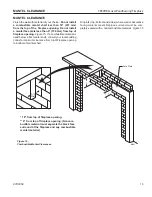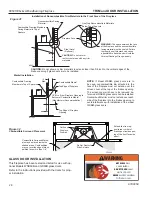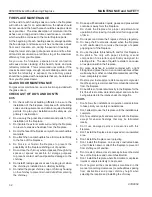
6
87D0058
SB50HB Series Woodburning Fireplace
gaS appLIaNCe INSTaLLaTION
WarNINg:
Improper installation or operation of a gas
appliance in this fireplace can allow unburned gas to leak
out which will cause a fire or explosion hazard, or the
release of poisonous carbon monoxide into the dwelling
which can cause serious injury or death to its inhabitants.
To reduce these risks to a minimum, the following important
notices and instructions should be read and followed
carefully.
IMpOrTaNT NOTICeS:
1. The provision for a gas line is intended for connection
to a decorative gas appliance which has an automatic
shutoff device and complies with the Standard for
Decorative Gas Appliances for Installation in Vented
Fireplaces, ANSI Z1.60. If a decorative gas appliance
is installed, it must be installed in accordance with the
National Fuel Gas Code, ANSI Z3.1.
CauTION:
“When a decorative gas appliance is
installed, the fireplace damper must be fixed in a
manner which will maintain the minimum permanent
vent opening at all times.”
If an unvented gas appliance (blue flame) is installed it
must incorporate an automatic shutoff device, and must
be installed in accordance with with the National Fuel
Gas Code Z3.1, Latest edition.
CauTION:
If an unvented gas appliance is installed in
the fireplace, the gas appliance must only be operated
with the fireplace glass door fully open (if included).
Only unvented gas log set which have been found to
comply with the standard for unvented room heaters,
ANSI Z1.11., are to be installed in this fireplace.
WarNINg:
Do not operate an unvented gas log set in
this fireplace with the chimney removed. The installer
of the fireplace and gas appliance must describe the
operation of the fireplace and appliance to the people
who will be operating them and leave all instruction
manuals with the operator of the appliance.
. An approved gas shut off valve must be located outside
the fireplace in an area accessible to the users of the
fireplace.
3. All gas piping and fitting must be either steel or malleable
iron. Unions must be of the ground joint type.
4. Some code authorities prohibit or place restrictions
on the use of gas appliances in fireplaces. Check
with local code authorities before proceeding with the
installation.
5. The gas appliance and all connecting gas piping should
only be installed by a licensed gas appliance installer.
The following instructions only apply to passing the gas line
through the fireplace wall. Follow the instructions provided
by the appliance for the gas line, testing and adjusting it.
1. Locate the recessed area in the side refractory panel
as shown by
Figure 30
.
. Tap out a round hole in the brick liner with a hammer
by tapping lightly on the recessed area.
3. Remove the two screws that hold the cover plates on
the jacket wrap and discard the cover plate.
4. Use a screwdriver or similar tool to push the loose
insulation out of the tube between the firebox and the
outer jacket of the fireplace.
5. Install the gas pipe through the tube between the firebox
and jacket.
6. Attach the gas appliance to the gas pipe according to
the appliance makers instructions.
7. Pack the insulation removed in step 4 around the pipe
to prevent air flowing through the tube either into or out
of the firebox.
8. Be sure the gas is turned off at the appliance, then
turn the gas on at the shut-off valve and test the gas
line connections for leaks with soapy water solution
or a liquid leak detector. DO NOT USE A MATCH
OR OTHER FLAME SOURCE TO CHECK FOR GAS
LEAKS. If a gas leak is detected, turn the gas off
immediately and fix the leak.
9. Proceed with testing the appliance for leaks and adjusting
it as required by the manufacturer instructions.











































